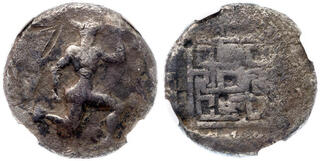| Dmitry Markov Coins & Medals | M&M Numismatics Ltd > Auction 60 | Auction date: 9 January 2024 |
| Lot number: 94 Price realized: 17,500 USD (Approx. 16,028 EUR) Note: Prices do not include buyer's fees. | Show similar lots on CoinArchives Find similar lots in upcoming auctions on |
| Lot description: Crete, Knossos. Silver Stater (12.15 g), ca. 440 BC The Minotaur in a kneeling-running stance right, its head facing. Reverse: The Labyrinth, in the form of a swastika. Svoronos pl. 4, 23 var.; Le Rider pl. XXIV, 25. Extremely Rare. NGC grade F; Strike: 4/5, Surface: 2/5. Edge marks and scuffs. This fascinating coin depicts an image of one of the most famous of all mythological creatures, the Minotaur, which had the head of a bull and the body of a man. The myth surrounding this beast dates from the period of the Minoan civilisation on Crete, long before the Greeks inhabited the island. The reasons for the destruction of the Minoan culture are not clear, but might have been the result of an earthquake or an invasion. When the Greeks discovered the complex remains of the palace of Knossos centuries later, the legend of the Minotaur and the Labyrinth were born. The Minotaur was said to have been imprisoned in the Labyrinth, designed by Daedalus for King Minos to hold it captive, and was fed with condemned criminals, maidens and young boys sent from Athens as tribute to the Cretan King. In the well-known mythical tale, the Minotaur was killed by Theseus, who had tied a ball of string, given to him by Ariadne, to the entrance to the Labyrinth upon entering so that he would be able to find his way back. When he discovered the Minotaur deep within the Labyrinth, a fierce struggle ensued before Theseus killed the monster with his sword.*Although this coin appears from its style to be archaic in origin, with the Minotaur positioned in the familiar kneeling-running stance, it does in fact date from the classical period. This is usually attributed to the fact that Crete was more isolated than the city-states on the mainland and therefore developed more slowly. Crete also relied upon imported coins for the silver used to strike its coinage. Estimate: 10000 USD |  |


